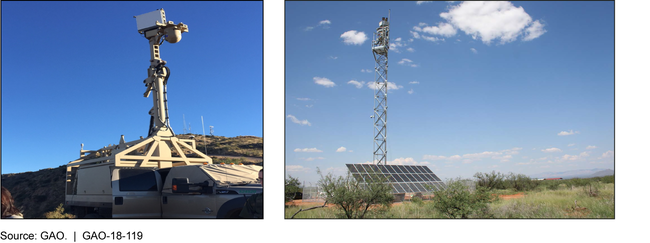Southwest Border Security: Border Patrol Is Deploying Surveillance Technologies but Needs to Improve Data Quality and Assess Effectiveness
Highlights
What GAO Found
The U.S. Border Patrol, within the Department of Homeland Security's (DHS) U.S. Customs and Border Protection (CBP), has made progress deploying surveillance technology along the southwest U.S. border under its 2011 Arizona Technology Plan (ATP) and 2014 Southwest Border Technology Plan. The ATP called for deployment of a mix of radars, sensors, and cameras in Arizona; the 2014 plan expanded these deployments to the rest of the southwest border. As of October 2017, Border Patrol had completed the planned deployment of select technologies to Arizona, Texas, California, and New Mexico. For example, in Arizona, Border Patrol deployed all planned Remote Video Surveillance Systems (RVSS) and Mobile Surveillance Capability (MSC) systems, and 15 of 53 planned Integrated Fixed Tower (IFT) systems. Border Patrol also deployed all planned MSC systems to Texas, California, and New Mexico and completed contract negotiations to deploy RVSS to Texas. These technology programs have experienced delays, but are currently on track against revised program schedules and cost baselines. To plan for future technology deployments, Border Patrol reports it will use its Requirements Management Process (RMP)––a process designed to facilitate planning by, among other things, identifying capability gaps and collecting agents' feedback––and other initiatives. Border Patrol is currently developing written guidance for the RMP to ensure station officials understand their roles and responsibilities in the process.
Mobile Surveillance Capability System and Integrated Fixed Tower, Arizona

Border Patrol agents collect and report data on asset assists, which are instances in which technologies or other assets (such as canine teams) contributed to an apprehension or seizure; however, Border Patrol has not provided sufficient guidance to ensure the accuracy and reliability of that data. For example, agents incorrectly attributed some apprehensions or seizures to certain technologies rather than others. Stations in the Rio Grande Valley sector recorded assists from IFTs in about 500 instances from June through December 2016; however, this sector does not have IFTs. Data integrity and quality checks are the responsibility of individual sectors, but Border Patrol has provided limited guidance on how to ensure data quality. Without sufficient guidance to ensure the quality of asset assist data, Border Patrol is limited in its ability to determine the mission benefits of its surveillance technologies and use information on benefits to inform resource allocation decisions.
Why GAO Did This Study
The southwest border has long been vulnerable to cross-border illegal activity. In fiscal year 2016, Border Patrol apprehended over 409,000 illegal entrants. Border Patrol has employed a variety of land-based surveillance technologies to assist in securing the border. GAO has reported regularly on CBP's progress and challenges deploying surveillance technologies.
GAO was asked to review CBP's use of surveillance technology. This report examines (1) the deployment status of surveillance technology programs and the extent to which CBP has developed plans for future technology deployments and (2) what data are available on the contributions of deployed technologies to CBP's border security efforts and the extent to which CBP has assessed technology performance.
GAO analyzed technology program documents; interviewed CBP and Border Patrol officials; and conducted site visits to Arizona and south Texas to observe the operation of various land-based technologies. We selected these locations because CBP has deployed or has plans to deploy a mix of technologies there, among other factors.
Recommendations
GAO recommends that Border Patrol issue guidance to improve the quality and usability of its asset assist information. DHS concurred with GAO's recommendation.
Recommendations for Executive Action
| Agency Affected | Recommendation | Status |
|---|---|---|
| U.S. Border Patrol | The Chief of the Border Patrol should issue guidance for sectors to improve the quality and usability of its surveillance technology asset assist information to help ensure it has reliable data so that Border Patrol can be better positioned to measure the impact of these technologies on its border security efforts and inform future investments. (Recommendation 1) |
In 2018, we identified issues with the completeness and reliability of Border Patrol's asset assist data. As a result, we recommended that Border Patrol issue guidance for sectors to improve the quality and usability of its surveillance technology asset assist information so that Border Patrol could better measure technology's impact on border security efforts and inform future investments. In response, Border Patrol took several actions. First, Border Patrol revised its asset assist training to include how sectors should conduct data integrity checks; why data is collected; how data can be used; and why Border Patrol needs to ensure data is accurately recorded. In February 2018, Border Patrol released a policy memo from the Acting Chief on the mandatory use of asset assists. Additionally, Border Patrol prepared and released a video from the Communications Division concerning asset assists. The video provides sector and station personnel with information on the importance of the asset assist data field. These actions should help Border Patrol improve the completeness and reliability of its asset assist data. Accordingly, we consider this recommendation closed as implemented.
|
